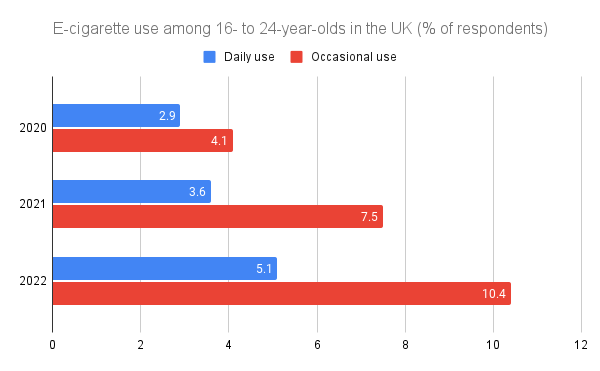Home › Blog – Gladstones Private Rehab Clinic › Vaping’s Victory: How E-Cigs Extinguished Joe Camel and the Marlboro Man
 For the longest time, smoking cigarettes was just about the coolest thing you could do. Think Humphrey Bogart’s character in 1942’s Casablanca, puffing away with an air of hard-edged sophistication; Audrey Hepburn with her elegant little cigarette holder in Breakfast at Tiffany’s; and, more recently, Brad Pitt as Tyler Durton in Fight Club, the ultimate symbol of rebellion with a cigarette barely clinging to his lips. Who was ever cooler than Joe Camel or manlier than the Marlboro Man?
For the longest time, smoking cigarettes was just about the coolest thing you could do. Think Humphrey Bogart’s character in 1942’s Casablanca, puffing away with an air of hard-edged sophistication; Audrey Hepburn with her elegant little cigarette holder in Breakfast at Tiffany’s; and, more recently, Brad Pitt as Tyler Durton in Fight Club, the ultimate symbol of rebellion with a cigarette barely clinging to his lips. Who was ever cooler than Joe Camel or manlier than the Marlboro Man?
While younger readers might not get these references due to cigarettes waning popularity over the last few decades, smoking, in some form or another, remains a popular pastime worldwide. For a short while there, around the early 2000s, we were all obsessed with hookahs and their plumes of smoke; however, these days many turn to tobaccoless alternatives, packaged in neat little sticks, available in every flavour you can imagine.
Tobacco-free smoking alternatives, specifically vapes or e-cigarettes, have seen a near-miraculous explosion in popularity over the course of the last few years. Since COVID-19, the number of people who have tried vaping or vape regularly has seen a two- to three-fold increase. Vapers will tell you that it’s helped them quit regular cigarettes. They’ll tell you that you can’t get addicted to vaping.
They’ll tell you that it’s harmless.
Is it?
In a word, the difference between vaping and smoking is combustion. The tip of a cigarette burns at around 650°C (Ermala and Holsti), creating smoke that contains roughly 7,000 chemicals, at least 69 of which are known to be carcinogenic (American Lung Association). Many of these chemicals are also associated with strokes, heart disease, and respiratory illnesses.
Vapes or e-cigarettes, on the other hand, work by heating a liquid known as e-juice, vape juice, or vaping liquid to generate an aerosol, commonly referred to as vapour, which the user then inhales. This glycerine- and glycol-based liquid typically contains nicotine and flavours. Unlike tobacco, which is incinerated when smoking, vape juice doesn’t burn. Instead, it’s heated to around 180 to 210°C, turning the liquid into vapour which is then inhaled.
The absence of combustion in vapes means significantly lower levels of carbon monoxide, tar, and other chemicals produced when organic matter burns. This lower level of harmful chemicals, along with the myriad of flavours available to vapers, is a strong driving force in vaping’s growing popularity.
In a direct comparison against traditional cigarettes, vaping does appear to carry a lot less risk, although the long-term effect of regular vaping isn’t fully understood yet. What we do know, however, is that vaping isn’t as harmless as many people seem to believe.
Arguably the biggest problem with vaping at this point is its popularity among teenagers and young people. Despite it being illegal to sell nicotine-containing substances to under-18s in the UK, the number of young people who have either tried vaping ‘just to see what it’s like’, or vape regularly, is on the increase.

Source: Office for National Statistics, ‘E-cigarette use in Great Britain’, 2023
This is a worrying statistic, as vaping, despite still being extensively studied, has already been associated with several health concerns. The primary of these, which relates specifically to young people, is nicotine’s effect on the developing brain. In addition to being an exceptionally addictive substance, nicotine can harm the areas of the brain responsible for attention, learning, mood, and impulse control (Center for Disease Control and Prevention). This problem is compounded by the fact that some nicotine-free vape liquids have been found to contain nicotine and that some manufacturers simply don’t disclose the nicotine content.
Other harmful substances that have been found in vape liquid and smoke include:
Source: Office for National Statistics, ‘E-cigarette use in Great Britain’, 2023
Although many teenagers and young adults have tried vaping because ‘a friend vapes and I wanted to try it’, casual experimentation can easily turn to dependency and addiction. Even small amounts of nicotine may cause nicotine withdrawal symptoms such as irritability, restlessness, concentration problems, and trouble sleeping, causing one to seek relief by continuing to vape or turning to other tobacco products (Truth Initiative).
Vapes and their consumables are often marketed in a way that makes them especially appealing to teenagers and even young children. It’s not uncommon to see vaporisers and vape liquid prominently displayed in brightly coloured packaging and available in flavours such as cherry peach lemonade, watermelon bubblegum, strawberry ice cream, and even gummy bear (BBC). Additionally, vape manufacturers often collaborate with influencers to showcase their products in a positive light, have active social media accounts demonstrating the latest and greatest in vape tech, and sponsor popular events such as music festivals, nightlife, and club events.
All of these factors have led to a proliferation of vaping in schools, with Public Health Wales going as far as publishing guidelines for secondary schools to tackle vaping and the King’s introduction of the Tobacco and Vapes Bill, aimed at curbing youth vaping.
Vaping also presents other, less obvious risks. Certain types of vape pens can be used to smoke cannabis; there’s the risk of spreading communicable diseases when sharing vapes; and the lithium-ion (LiPo) batteries used in vapes are known to occasionally explode, potentially starting fires or causing serious bodily harm when on one’s person.
Giving up smoking is easy. I've done it hundreds of times.
Mark Twain
Putting down the vape for good can be challenging for exactly the same reason that giving up cigarettes is, and more. Nicotine in tobacco and vape liquid affects the brain’s reward systems in the same way that many narcotics do; first leading to pleasurable effects, then cravings and withdrawal symptoms. Additionally, vaping has become integrated into many people’s daily and social routines, making vaping more than just a physical addiction but a psychological one. Finally, the widespread acceptance of vaping and the public’s perception that it’s risk-free or carries minimal risk can undermine the motivation to quit.
If, however, one is serious about quitting vaping, here are some tips to make it easier:
As a leader in addiction recovery and rehabilitation, the specialists at Gladstones Clinic have a deep and comprehensive understanding of the mechanisms of addiction and the treatment options available. We’re also one of only a handful of rehab facilities in the UK that offer specialised rehab treatment for teenagers.
American Lung Association. “What’s In a Cigarette?” American Lung Association, American Lung Association, 31 May 2023, https://www.lung.org/quit-smoking/smoking-facts/whats-in-a-cigarette. Accessed 14 February 2024.
American Lung Association. “What’s in an E-Cigarette?” American Lung Association, 31 May 2023, https://www.lung.org/quit-smoking/e-cigarettes-vaping/whats-in-an-e-cigarette. Accessed 14 February 2024.
Centers for Disease Control and Prevention. “Quick Facts on the Risks of E-cigarettes for Young People.” Centers for Disease Control and Prevention, Centers for Disease Control and Prevention, 2023, https://www.cdc.gov/tobacco/e-cigarettes/youth.html?CDC_AAref_Val=https://www.cdc.gov/tobacco/basic_information/e-cigarettes/Quick-Facts-on-the-Risks-of-E-cigarettes-for-Kids-Teens-and-Young-Adults.html. Accessed 14 February 2024.
Ermala, P., and L. R. Holsti. “On the Burning Temperatures of Tobacco.” Cancer Research, American Association for Cancer Research, 19 May 2023, https://aacrjournals.org/cancerres/article/16/6/490/473384/On-the-Burning-Temperatures-of-Tobacco. Accessed 14 February 2024.
Office for National Statistics. “Dataset E-cigarette use in Great Britain.” Office for National Statistics, Office for National Statistics, 5 September 2023, https://www.ons.gov.uk/peoplepopulationandcommunity/healthandsocialcare/drugusealcoholandsmoking/datasets/ecigaretteuseingreatbritain. Accessed 14 February 2024.
Truth Initiative. “Colliding Crises: Youth Mental Health and Nicotine Use.” Truth Initiative, Truth Initiative, 8 September 2021, https://truthinitiative.org/sites/default/files/media/files/2021/09/Mental-Health-and-Nicotine-Report.pdf. Accessed 14 February 2024.
Watson, Calum. “How can we stop children vaping?” BBC, BBC, 2023, https://www.bbc.com/news/uk-scotland-67426340. Accessed 14 February 2024.




With over 15 years experience our integrated approach to treating Mental Health & Addictions has transformed the lives of hundreds of people by empowering and supporting them to take back control of their lives.
GLADSTONES CLINIC LIMITED
The Wyastone Business Park
Wyastone Leys, Ganarew
Monmouth, NP25 3SR
Gladstones Clinic Cotswolds
Narles Farm, Dursley Road
Cambridge
Gloucestershire
GL2 7AB
Tel: 01453 890184
Gladstones Clinic London
64 Waverley Gardens
London
NW10 7EE
Tel: 020 8964 8516
Gladstones Clinic Bristol
48 St Paul’s Road
Clifton
Bristol
BS8 1LP
Tel: 0117 925 2995
Gladstones Clinic Cornwall
66 Lemon Street
Truro
Cornwall
TR1 2PN
Tel: 0117 925 2995
Copyright 2025 Gladstones Clinic – All Rights Reserved | Privacy Policy | Privacy Settings | Company Number: 07607877
If you would like to request a callback from our support team, please fill out the form below and we’ll get in touch with you as soon as possible.
